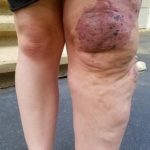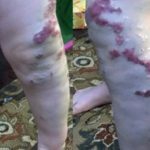 Clippel-Trenone-Weber Syndrome( English: Klippel-Trenaunay syndrome) is a congenital anomaly affecting the lower limbs.
Clippel-Trenone-Weber Syndrome( English: Klippel-Trenaunay syndrome) is a congenital anomaly affecting the lower limbs.
This refers to the underdevelopment or aplasia( absence) of the deep veins of the limb in the presence of a superficial venous system. Problems usually arise in childhood and progress further. The syndrome of Klippel-Trenone is its typical symptoms, on the basis of which the disease is easily diagnosed.
Contents
- Characteristics of the disease
- Etiology, causes and risk factors
- Clinical picture
- Diagnosis of
- Medical care
Characteristic of the disease
Klippel's syndrome Trenone is one of the most common systemic phleboangiodysplasias. The disease is characterized by malformations( deviations from normal development, causing disorders in the function of organs or tissues) of the skin capillaries( in the specialized literature, usually the Latin name is "naevus fl ammeus"), excessive growth of the soft and bony tissues of the affected area, as well as lymphatic and venous malformations.
The origin of the syndrome is sporadic, men and women become ill the same often, a racial advantage is not identified;symptoms may appear at birth or during childhood.63% of patients have all the signs, 37% of patients have only 2 symptoms from the clinical triad.

Etiology, causes and risk factors
The etiology of Klippel Trenone syndrome is unclear. There are various hypotheses:
- , the first theory suggests that intrauterine damage to the sympathetic ganglia of the intermediolateral tract leads to dilatation of microscopic arterio-venous anastomoses, from which malformation of the vessels may develop;
- in accordance with the second hypothesis, the blocking of normal venous outflow into the deep venous system leads to the formation of venous hypertension and varicose veins;
- The third hypothesis suggests that the main cause of the disease is mesodermal disorder, which causes the preservation of microscopic arterio-venous anastomoses.
Despite the unclear etiology, most experts tend to favor the hypothesis that the disease is caused by a mesodermal anomaly that forms in the early stages of fetal development.
Development of the normal vascular branch of the embryo is the result of angiogenesis, vasculogenesis and vascular remodeling. In this complex process, various vascular endothelial growth factors( VEGF) are important regulators.
VEGF binds to the tyrosine kinase receptor( VEGF-R1 and VEGF-R2) and modulates endothelial proliferation and vascular formation is a process that depends largely on the antagonist, angiopoietin-2.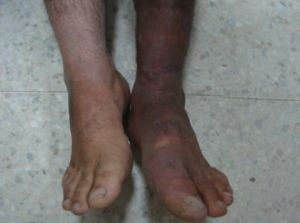
It is very likely that in the Klippel-Trenone-Weber syndrome there is a definite change in vascular remodeling, possibly at the level of modified angiopoietin-2.
This is a fairly rare disease, for the last 30 years there have been no cases of the syndrome being diagnosed in members of the same family. Hence the genetic trace is missing.
However, there are earlier records that indicate the occurrence of the disease in several members of the same family.
Clinical picture of
The Klippel-Trenone syndrome is characterized by a triad of symptoms, some of which are sometimes evident at birth, others may appear later on with the progression of the disease:
- Reddish skin color( port color) , more often one-sided, on the upper and lower extremities. This feature is present in 75% of cases.
- The venous disorders of appear. It is a question of a varicose expansion of veins, arising already in the childhood. This symptom is often accompanied by varicose veins of the perineal and suprapubic areas. In 20% of cases, there is no deep venous system. In 70% of patients, there are enlarged veins on the lateral side of the lower leg, on the thigh or both. Varicose veins are emptied into the saphenes or, depending on the level, into the deep veins of the extremities. The clinical picture includes symptoms of chronic venous insufficiency, often - thrombophlebitis or deep vein thrombosis( about 20% of cases).Formation of venous ulcers is observed in approximately 1-2% of patients. Quite often there is also lymphedema( 15%).
- Hypertrophy of soft parts and bones of the limb .The symptom is manifested even at birth and becomes noticeable in the process of growth. Symptoms are usually one-sided. Hypertrophic is the finger on the leg( sometimes it needs an amputation so that a person can wear shoes).
 Other malformations complement the classic clinical picture. Hypoplasia of the lymphatic vessels leads to lymphedema. Cavernous angiomas may be present on the large intestine and bladder. Epidural hemangioma can lead to compression of the spinal cord. Other signs include anomalies of the vertebrae, teeth and facial asymmetry.
Other malformations complement the classic clinical picture. Hypoplasia of the lymphatic vessels leads to lymphedema. Cavernous angiomas may be present on the large intestine and bladder. Epidural hemangioma can lead to compression of the spinal cord. Other signs include anomalies of the vertebrae, teeth and facial asymmetry.
People who have at least 2 of the 3 main symptoms of the disease are classified as patients with incomplete form of the Klippel-Trenone syndrome.
It is also necessary to mention the existence of the inversion form of the syndrome, when the area with vascular malformation is hypotrophic, and, mainly, hypotrophy is due to congenital atrophy of adipose tissue, less often there is muscle mass hypotrophy.
Photo-compilation and video of patients with Klippel's syndrome Trenone Weber:
Diagnosis of
Anomaly is diagnosed immediately at birth on the basis of clinical symptoms and in the further development of the child, when the typical manifestations of the disease become more apparent.
In case of complications and deterioration of the state, visualization methods are used. Ultrasound examination of the lower extremities, CT( computed tomography), magnetic resonance imaging( MRI) is used to study soft tissues.
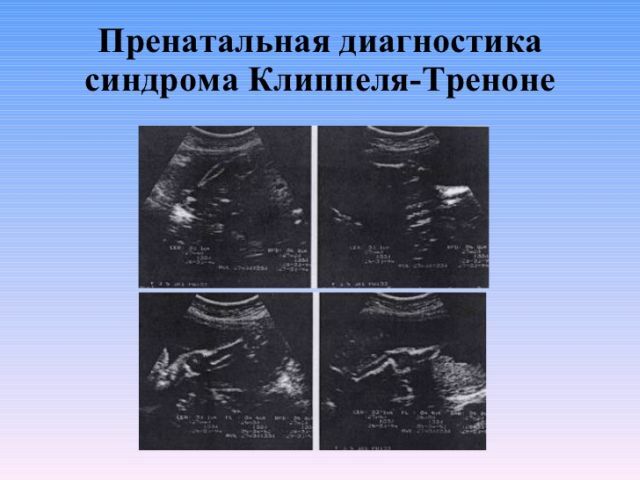
Medical care
The choice of method of treatment depends on the degree of the disease, the severity of the symptoms and the clinical condition of the patient. Given the nature of the lesions, as well as the possibility of developing chronic venous insufficiency, patients with the Klippel-Trenone syndrome usually receive conservative treatment.
There is no medication or method by which it is fashionable to cure the disease, so the therapy is aimed at alleviating the symptoms and preventing the progression of the disease.
Conservative treatment includes:
- recommended compression stockings or pantyhose that protect feet from damage, reduce swelling;
- for inflammation of varicose veins prescribed painkillers and antibiotics in the form of ointments or in the form of tablets;
- for the formation of thrombi drugs are introduced to dissolve them, ie, drugs for dilution of blood.
Surgical treatment is recommended if conservative therapy does not show efficacy. Unfortunately, not every vascular 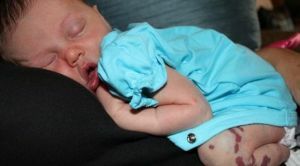 malformation can be solved surgically once and for all.
malformation can be solved surgically once and for all.
Orthopedic surgery is recommended in case one leg is longer than the other( osteotomy is performed).
Sometimes the disease leads to certain complications. The relatively frequent consequences of the Klippel-Trenone syndrome include the following:
- skin infections;
- pulmonary embolism, which occurs when a blood clot blocks a blood vessel in the lungs;a clot, as a rule, is formed in the leg;
- fusion of the fingers or excessive amount on the foot or hand.
With the right therapeutic approach, the prognosis for patients is relatively optimistic.
Preventive measures include a genetic study of a couple in the planning of pregnancy( mainly conducted in the presence of a family history of the disease).This will help determine the risk of having a baby with this disorder. Prevention, as such, does not exist - the disease can not be prevented.



